The trails at Hilton Pond Center have been especially pleasant this fall, with unseasonably warm days, low humidity, and tons of freshly fallen leaves to shuffle through. We've enjoyed perambulating the paths--and sharing them with others who have come for Guided Field Trips. One sunny day this week, for example, nature lovers Laura Jay and her sister, Hattie Griffin, got up well before dawn and made the long drive from Atlanta to York SC--just to see how we manage Hilton Pond and the property that surrounds it. (Note to Laura: Remember, aside from chopping down invasive plants, we do almost nothing except let Mother Nature take care of herself through natural succession.) As we strolled the 11 acres talking and looking at "all kinds of really neat nature stuff," Laura and Hattie noticed something a little unsettling: We came across little piles of feathers, one after the other, in the leaf litter. First was the plucked plumage of a Northern Cardinal, then a Northern Bobwhite, and finally a Hairy Woodpecker (below). Laura and Hattie wondered what had happened to these birds, and we replied they undoubtedly had fallen victim to an Avian Apocalypse--most likely the fast-flying Cooper's Hawk that has been hanging out at Hilton Pond since early November.
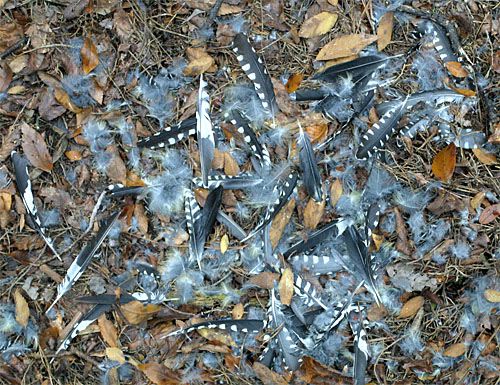
All text & photos © Hilton Pond Center
Despite their initial alarm, Laura and Hattie recognized that--unlike free-roaming "house" cats--bird-eating hawks are part of the natural balance of nature in the Piedmont, and something that many observers never get to see. The two woman didn't actually observe the hawk during their sunny-day visit, but could deduce from the evidence that a raptor had been present. The next morning (20 November 2004) another Guided Field Trip--this one sponsored by Chirp 'n Chatter wild bird store in Tega Cay SC--had a very different experience, and not just because it was chilly and overcast. As the group examined a live Tufted Titmice we had just trapped, a large brown object hurtled into a nearby mist net and bounced along its length. We knew immediately it was the resident Cooper's Hawk--coming to our backyard feeding station for brunch--so we ran to the net before this elusive raptor could gather its wits and get unsnared. Fortunately, its long toes caught in the net mesh and we were able to subdue it long enough to get a grip on its legs.

One thing you DON'T want to do with a hawk in a net is lower your guard. Although their bills are sharp they seldom bite, but these predatory birds will lash out in an instant and imbed their talons (above) in a finger or hand--something that is painful AND brings the risk of a deep staph infection. Since it's nearly impossible to extricate a bird from a net while wearing gloves, we held tightly to the hawk's drumsticks while removing netting from its wings and toes. This was no easy task because the hawk was without a doubt the most boisterous and vigorous bird we've ever netted AND it was also our very first Cooper's Hawk. We could hardly contain ourselves, since that meant this hawk was soon to become the 124th species banded at Hilton Pond Center since 1982.
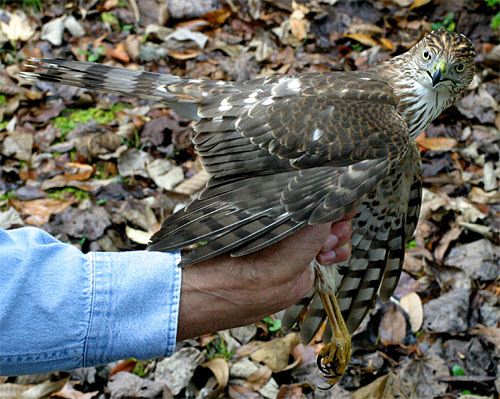
We were amazed at the strength of this Cooper's Hawk, which struggled the whole time we removed it from the net and then flapped repeatedly--and hard!--while we had it in hand. We've banded quite a few Sharp-shinned Hawks (the Cooper's Blue Jay-sized cousin) and even Red-shouldered Hawks almost twice the Cooper's size, but none of them were nearly as strong or as animated as this new Hilton Pond banding species. In addition to putting up a physical fight, the fiesty Cooper's Hawk called raucously and loudly enough to hurt our ears.
Based on its size, we initially thought our Cooper's Hawk was a female; among most birds of prey, males are smaller than their mates and this one seemed pretty big. When we consulting the literature, however, we learned that females have a wing chord of 251mm or more, and our bird measured a "mere" 229mm. Since this aggressive individual was a male and females are at least one-third larger, we can imagine it might take TWO people to hold down an energetic female Cooper's Hawk!
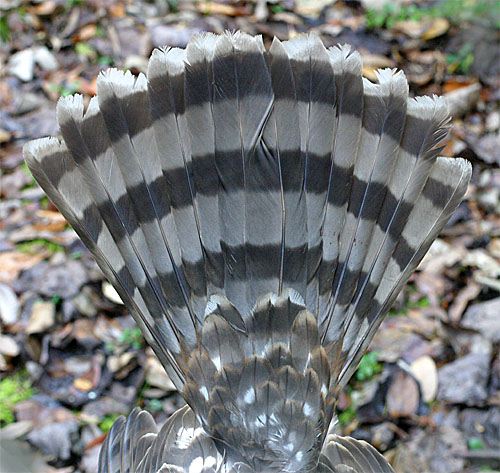
As their scientific name indicates, Cooper's Hawks--Accipiter cooperii--are classified as accipiters. And, as Laura Jay and Hattie Griffin discovered from all those feather piles, accipiters are the so-called "bird-eating hawks." The genus also includes the smaller, more common Sharp-shinned Hawk, A. striatus, and the larger Northern Goshawk, A. gentilis, a species only rarely seen in the Carolinas.  Accipiter hawks have long, broadly banded tails (above) and rather short, rounded wings that can be used for soaring but serve the hawks best when they try to navigate forested areas in pursuit of prey. We we worked at Hawk Mountian Sanctuary in Pennsylvania, we got quite familiar with all three North American accipiters as thousands of them sailed over North Lookout in mid-October. Accipiter hawks have long, broadly banded tails (above) and rather short, rounded wings that can be used for soaring but serve the hawks best when they try to navigate forested areas in pursuit of prey. We we worked at Hawk Mountian Sanctuary in Pennsylvania, we got quite familiar with all three North American accipiters as thousands of them sailed over North Lookout in mid-October.
Sharpies (adult at a feeder at left) and Coops look very much alike--sometimes it's hard to differentiate them on the wing--but typically the sharp-shin has a tail that is square or notched while the Cooper's is usually noticeably rounded. Since we had seen our newly captured hawk perched, flying, and now in the hand, we had many good looks at the tail, and it definitely had the rounded shape expected in a Cooper's.

Like several raptor species, Cooper's fledge the nest with yellow irises (above); these darken with age, first becoming orange and later deep, clear red. Based on this character alone, we called our hawk a juvenile that must have hatched in 2004. Further evidence of its age included a breast with vertical brown streaking (below); in adults, this is replaced by fine horizontal chestnut-colored bars. Fast-flying adult Cooper's Hawks eventually develop bluish-gray backs and wings that give rise to their nickname of "blue darter." Incidentally, it's hard to know the origin of our Hilton Pond Cooper's Hawk, since the species breeds in every contiguous state, southern Canada, and northern Mexico.
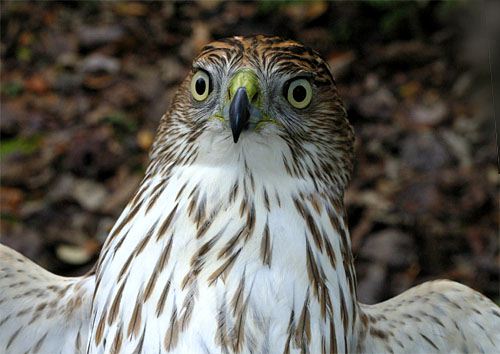
The strong, feisty Cooper's we caught this week required more than the typical "butt bands" we use for songbirds and hummingbirds. Butt bands simply close around a bird's leg, but for the hawk we used a "lock-on band" with two flanges (below), one of which folds over the other and holds it in place. The hooked bill of a Cooper's Hawk is strong enough to pry open a standard butt band, so a lock-on is required. Although the lock-on band still rotates and slides freely on the bird's leg, there's no way the hawk can remove its new two-flanged jewelry. Likewise, it didn't seem likely the hawk would be getting rid of two three-eighths-inch-long Hippoboscid Flies that occasionally crawled out of its feathers during the banding process. These flat, blood-sucking hitchhikers--sometimes called "Louse Fies"--occur on most birds but are very species-specific; e.g., one-eighth-inch flies that parasitize Dark-eyed Juncos are a different species than the much bigger ones on the hawk.
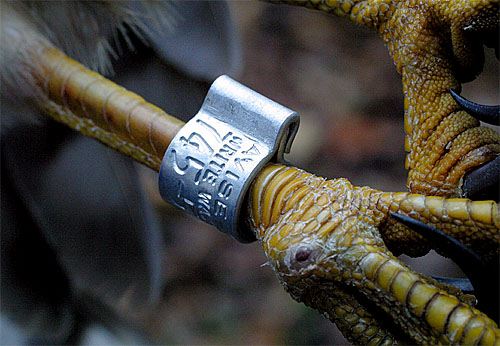
Now that we've been trapping and netting at Hilton Pond Center for more than 22 years, it's not often we add new banding species, so 20 November was indeed an eventful day. After the folks from Chirp n' Chatter departed we even caught our first Brown-headed Nuthatch, White-breasted Nuthatch, and Hermit Thrush of the year. Those were neat birds to get, but none could compare with the Cooper's Hawk. When we finally released this aggressive woodland raptor, it headed off through the trees in a southeastern direction, and we haven't seen it since. Happy as we were to observe, capture, and band our first-time Cooper's, we won't be too disappointed if this "Avian Apocalypse" departs for other hunting grounds where it can leave little piles of feathers on someone else's trails.
All text & photos © Hilton Pond Center
Comments or questions about this week's installment?
Please send an E-mail message to INFO.
NOTE: Be sure to scroll down for an account of all birds banded or recaptured during the week, as well as some other interesting nature notes.
"This Week at Hilton Pond" is written & photographed
by Bill Hilton Jr., executive director of
Hilton Pond Center for Piedmont Natural History.
You may wish to consult our Index of all nature topics covered since February 2000. You can also use the on-line Search Engine at the bottom of this page.
For a free, non-fattening, on-line subscription to "This Week at Hilton Pond," just send us an E-mail with SUBSCRIBE in the Subject line. Please be sure to configure your spam filter to accept E-mails from hiltonpond.org.

Catch the video version of "This Week" each Friday during the
6 p.m. newscast on CN2 cable news network in Rock Hill SC. (Repeated every half hour through the night.)
|





 Accipiter hawks have long, broadly banded tails (above) and rather short, rounded wings that can be used for soaring but serve the hawks best when they try to navigate forested areas in pursuit of prey. We we worked at Hawk Mountian Sanctuary in Pennsylvania, we got quite familiar with all three North American accipiters as thousands of them sailed over North Lookout in mid-October.
Accipiter hawks have long, broadly banded tails (above) and rather short, rounded wings that can be used for soaring but serve the hawks best when they try to navigate forested areas in pursuit of prey. We we worked at Hawk Mountian Sanctuary in Pennsylvania, we got quite familiar with all three North American accipiters as thousands of them sailed over North Lookout in mid-October. 





 Oct 15 to Mar 15
Oct 15 to Mar 15 You can also
You can also